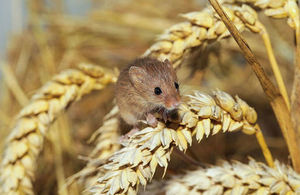Iconic harvest mouse returns to Hampshire village
Iconic harvest mouse immortalised by Beatrix Potter returns to Hampshire village where it was first discovered

The iconic Harvest Mouse has been found in a Hampshire village more than 25 years after it was thought to have been locally extinct thanks to an innovative new farming method.
Environment Secretary Elizabeth Truss today announced the discovery of more than 150 nests around Selborne village, the birthplace of the famous naturalist Gilbert White who was responsible for distinguishing micromys minutus, or the Harvest Mouse, as a species in 1767.
The Selborne Farmer Cluster has brought together local farmers so they can achieve greater ecological benefits by protecting a wider landscape than just their own individual farmland. Environment Secretary Elizabeth Truss is visiting the cluster around the village where the mice were last seen in 1990.
Environment Secretary Elizabeth Truss said:
As an avid reader of Beatrix Potter in my youth I’m delighted that the iconic Harvest Mouse has been rediscovered in the very area in which it was first identified.
The farmers of Selborne should be congratulated for the innovative approach they have taken to managing their land for the good of the environment and local wildlife.
The Selborne farmer cluster is a great example of responsible landowners thinking beyond their own fields, meadows and woodlands and looking at the wider landscape to deliver greater environmental benefits on a larger scale.
This approach to land management is at the heart of our 25-year Environment Plan, which will bring people together to work in a more co-ordinated way to conserve and enhance the environment. Without a healthy environment, we won’t have a healthy farming industry.
The 25-year Environment Plan is set to help conserve our precious environment by boosting co-ordination and encouraging people to work more closely together, which is exactly what this farmer cluster model is achieving.
The Selborne farmers joined forces with volunteers to conduct surveys of field mice nests and carried out vital work such as hedge laying, hedge planting and the maintenance of grass headlands around arable fields to create habitats. By working collectively, the Selborne cluster has created a connected habitat for birds, small mammals and insects.
In addition to biodiversity improvements, the farmer cluster method of working can bring economic benefits. Managing flood resilience, for example, is more effective if the land is looked at as a whole within a water catchment area, as opposed to individual units.
The 25-year Environment Plan is set to help conserve our precious environment by boosting co-ordination and cohesive working between people, which is exactly what this farmer cluster model is achieving.
One of nine clusters within England, the Selborne group consists of 11 farmers, covers 4,000 hectares and is led by the Game & Wildlife Conservation Trust. It works with the South Downs National Park as part of the Selborne Landscape Partnership.
Natural England is providing support for the running costs of the Selborne project, as well as advice on linking the conservation work to the wider landscape, including Woolmer Forest to the east and heathland to the west.
Notes to Editor
-
For further information on our 25-year Environment Plan, due to be published later this year, please go to the Open Environment speech by Elizabeth Truss
-
For further information on farming clusters please contact the Game & Wildlife Conservation Trust on 01425 651037.
-
For any additional information please contact Defra press office on 020 7238 6443.
Photo credit: Natural England/Allan Drewitt